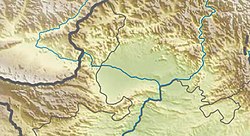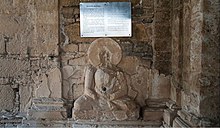
Sarnath is a place located 10 kilometres northeast of Varanasi, near the confluence of the Ganges and the Varuna rivers in Uttar Pradesh, India.

Taxila or Takshashila is a city in the Pothohar region of Punjab, Pakistan. Located in the Taxila Tehsil of Rawalpindi District, it lies approximately 25 kilometres (16 mi) northwest of the Islamabad–Rawalpindi metropolitan area and is just south of the Haripur District of Khyber Pakhtunkhwa.
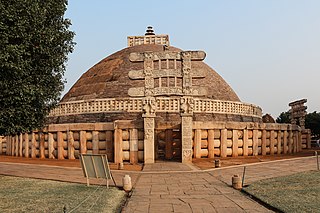
In Buddhism, a stupa is a mound-like or hemispherical structure containing relics that is used as a place of meditation.

Sirkap is the name of an archaeological site on the bank opposite to the city of Taxila, Punjab, Pakistan.

Haḍḍa is a Greco-Buddhist archeological site located ten kilometers south of the city of Jalalabad, in the Nangarhar Province of eastern Afghanistan.

Takht-i-Bahi, is an Indo-Parthian archaeological site of an ancient Buddhist monastery in Mardan, Khyber-Pakhtunkhwa, Pakistan. The site is considered among the most important relics of Buddhism in all of what was once Gandhara.

The Butkara Stupa is an important Buddhist stupa near Mingora, in the area of Swat, Pakistan. It may have been built by the Mauryan emperor Ashoka, but it is generally dated slightly later to the 2nd century BCE.
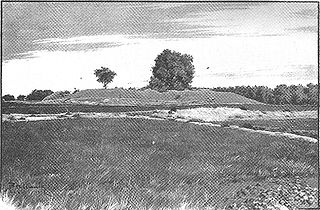
The Kanishka Stupa was a monumental stupa established by the Kushan king Kanishka during the 2nd century CE in today's Shaji-ki-Dheri on the outskirts of Peshawar, Pakistan.

The Dharmarajika Stupa, also referred to as the Great Stupa of Taxila, is a Buddhist stupa near Taxila, Pakistan. It was built over the relics of the Buddha by Ashoka, the Emperor of Magadha, in the 3rd century BCE. The stupa, along with the large monastic complex that later developed around it, forms part of the Ruins of Taxila - which were inscribed as a UNESCO World Heritage Site in 1980.

Buddhism in Pakistan took root some 2,300 years ago under the Mauryan king Ashoka who sent missionaries to the Kashmira-Gandhara region of North West Pakistan extending into Afghanistan, following the Third Buddhist council in Pataliputra.

Mankiala is a village in the Potohar plateau, Punjab near Rawalpindi, Pakistan, known for the nearby Mankiala stupa – a Buddhist stupa located at the site where, according to legend, Buddha sacrificed some of his body parts to feed seven hungry tiger cubs.

Sirsukh is an ancient city that forms part of the ruins at Taxila, near the modern day city of Taxila, Punjab, Pakistan.

Mohra Muradu is the place of an ancient Buddhist stupa and monastery near the ruins of Taxila, in the Punjab province of Pakistan. The ancient monastery is located in a valley and has views of the surrounding mountains. The monks could meditate in all stillness at this place but were near enough to the city of Sirsukh to go for begging as it is only around 1.5 km away. The city is said to have been built the 2nd century CE and renovated in the 5th century.

The Pothohar Plateau, also known as Pothwar, is a plateau in the northern region of Punjab, Pakistan, located between the Indus and Jhelum rivers.
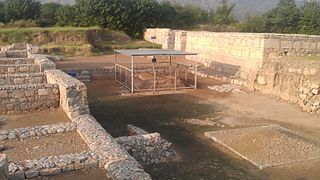
Jinnan Wali Dheri is an archaeological site near Taxila, Pakistan. It is the remains of a Buddhist monastic complex dating to the 5th century AD, part of the remains of the Gandhara civilization. It is one of the best-preserved Buddhist monastic complexes in the Taxila valley. The complex includes a main stupa, votive stupas, an enclosure around the main stupa provided with chapels facing towards main stupa, two platforms of rather late period constructed in front of the chapels situated on the both corners of the eastern wall, an upper court votive stupa and a monastery/sangharama on the eastern side of the stupa.

Jamal Garhi is a small town located 13 kilometers from Mardan at Katlang-Mardan road in Khyber Pakhtunkhwa province in northern Pakistan. Jamal Garhi was a Buddhist monastery from the first until the fifth century AD at a time when Buddhism flourished in this part of the Indian subcontinent. The monastery and main stupa are surrounded by chapels closely packed together. The site is called "The Jamal Garhi Kandarat or Kafiro Kote" by the locals.

Bhamala Stupa is a ruined Buddhist stupa and World Heritage Site near Haripur, Pakistan, that dates to the 2nd century CE. It is located on the banks of the Haro River, near Khanpur Dam, and is a tourist destination. Bhamala stupa is part of the larger Bhamala Buddhist Complex. The site is known for its 1,700-year-old statue of the Buddha attaining enlightenment—considered to be the oldest such statue in the world.

Chandavaram Buddhist site is an ancient Indian Buddhist site in Chandavaram village in Prakasam district in the Indian state of Andhra Pradesh. Situated on the bank of Gundlakamma River, the site is 10 kilometres (6.2 mi) northwest of Donakonda railway station. The Chandavaram Buddhist site was built between the 2nd century BCE and the 2nd century CE during the Satavahana dynasty and was discovered by Veluri Venkata Krishna Sastry in 1964.

The Manikyala Stupa or Mankiala Stupa is a Buddhist stupa near the village of Tope Mankiala, in the Pothohar region of Pakistan's Punjab province. The stupa was built to commemorate the spot, where according to the Jataka tales, an incarnation of the Buddha called Prince Sattva sacrificed himself to feed seven hungry tiger cubs.

Fayaz Tepe, also Fayoz-Tepe, is a Buddhist archaeological site in the Central Asia region of Bactria, in the Termez oasis near the city of Termez in southern Uzbekistan. Located 15 km west of Termez off the main M39 highway. Bus number 15 runs past the turn-off to Fayaz Tepe, from where it is a 1 km walk without shade. The foundations of the site date to the 1st century CE, with a peak of activity around the 3rd and 4th centuries during the Kushan period, before experiencing a fatal decline around the 5th century CE, probably with the invasion of the Kushano-Sassanian, whose coinage can be found at the nearby site of Kara Tepe.



